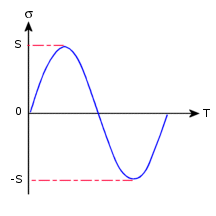Evaluation of Alternating Stresses From Constant Amplitude Fatigue Events
One Event Defined by a Single Fatigue Load

-
User-defined load ratio: Assuming that the user-defined load ratio is R, the program gets one of the peaks from the reference study (considering specified scale factor) and calculates the other peak by multiplying the first peak by R. The program then calculates the stress quantity selected in the
Fatigue
properties dialog box and calculates the alternating stress as |S*(1 - R)|/2 where S is the extreme value of the stress component in the reference static study.

Single Event Defined by Multiple Fatigue Loads
The program calculates the alternating stresses for each node by considering the combination of peaks from different fatigue loads. The fatigue loads can refer to one or more static studies.
Suppose that you specified fatigue loads using studies A, B, and C with scale factors F
A
, F
B
, and F
C to define an event. In order to evaluate the alternating stress and the associated stress ratio at a node, the program proceeds as follows:
-
It evaluates SA*FA, SB*FB, and SC*FC, where SA, SB, and SC refer to the stress component values at the node for studies A, B, and C, respectively. The program calculates the associated values for the SX, SY, SZ, TXY, TXZ, and TYZ components.
-
Evaluates the differences in the stress quantity specified for calculating the alternating stresses for all possible combinations of stress peaks and determines the combination that produces the largest stress fluctuation.
-
Evaluates the alternating stress associated with the event by dividing the stress fluctuation range by 2.
-
Calculates the stress ratio based on the calculated stress extremes (Smin and Smax).
-
If multiple S-N curves with different stress ratios are defined, the program uses linear interpolation to extract the proper number of cycles for the calculated alternating stress and stress ratio.
-
If a single S-N curve with zero mean is defined and a mean stress correction method is selected, the program uses the corrected alternating stress against the S-N curve.
Multiple Events
Evaluating alternating stresses for multiple events depends on whether the events occur randomly or independently. This option is available in the Fatigue dialog box.
No Interaction between Events
The program evaluates the alternating stress separately as explained above for the different loading types.
Random Interaction between Events
The program evaluates the maximum alternating stress by considering all possible combinations of fatigue loads at each node. The program then uses the Miner’s rule and the ASME Boiler and Pressure Vessel Code to define a set of modified fatigue events.
This approach predicts a higher damage factor than applying the defined events sequentially unless the stress peaks from different events are marginally different. In such cases, it is recommended to run two different studies; one study with no interaction between events and the otherstudy with random interaction. The results can reveal that one option gives higher damage at some locations while the other option gives higher damage at other locations.
Example 1
User-defined events
Event 1: 8000 cycles stresses alternating between 900 psi and -400 psi
Event 2: 2000 cycles alternating between 700 psi and -700 psi
Modified events
Event 1: 2000 cycles with alternating stress (900 + 700)/2 = 800 psi
Event 2: 6000 cycles with alternating stress (900 + 400)/2 = 650 psi
Example 2
User-defined events
Event 1: 8000 cycles stresses alternating between 900 psi and -400 psi
Event 2: 2000 cycles with alternating between 700 psi -402 psi
Modified events
Event 1: 2000 cycles 900 psi with alternating stress (900 + 402)/2 = 651 psi
Event 2: 6000 cycles 900 psi with alternating stress (900 + 400)/2 = 650 psi
The independent event approach is likely to be more conservative in this case.
Related Topic
Fatigue Analysis
Fatigue Plots